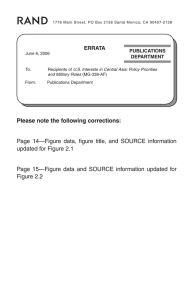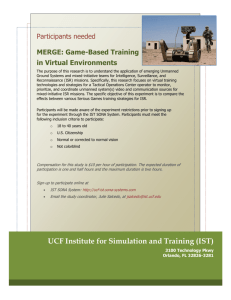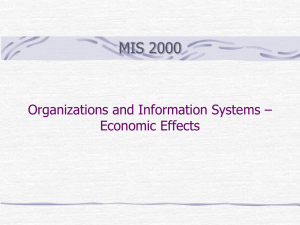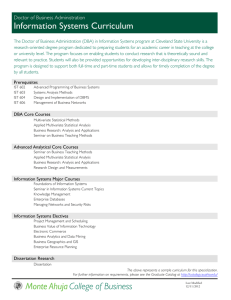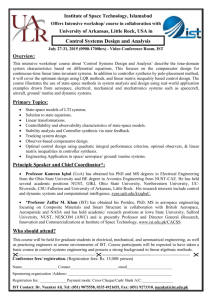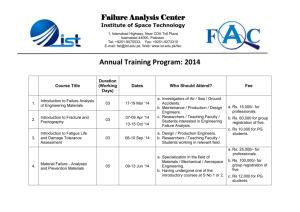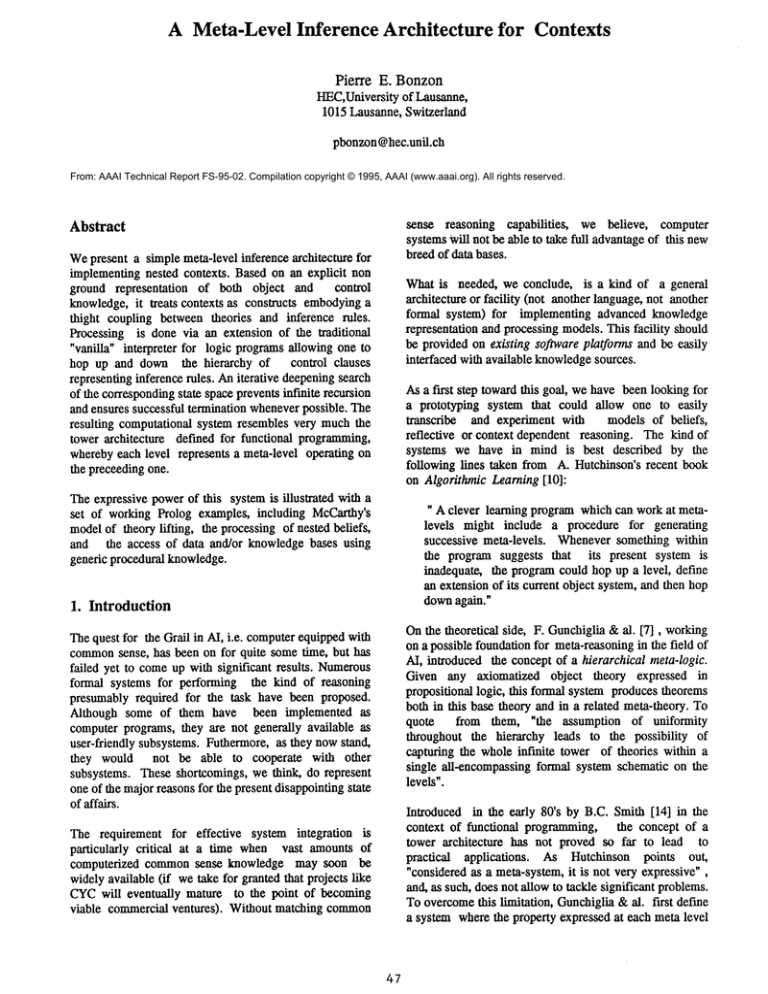
A Meta-Level Inference Architecture
for Contexts
Pierre E. Bonzon
HF,C,Universityof Lall.e,.qnne,
1015 Lausanne, Switzerland
pbonzon@hec.unil.ch
From: AAAI Technical Report FS-95-02. Compilation copyright © 1995, AAAI (www.aaai.org). All rights reserved.
sense reasoning capabilities,
we believe, computer
systems Will not be able to take full advantage of this new
breed of data bases.
Abstract
Wepresent a simple recta-level inference architecture for
implementing nested contexts. Based on an explicit non
ground representation
of both object and control
knowledge, it treats contexts as constructs embodyinga
thight coupling between theories and inference rules.
Processing is done via an extension of the traditional
"vanilla" interpreter for logic programs allowing one to
hop up and down the hierarchy of control clauses
representing inference rules. Aniterative deepeningsearch
of the correspondingstate space prevents infinite recursion
and ensures successful termination wheneverpossible. The
resulting computational system resembles very much the
tower architecture defined for functional programming,
wherebyeach level represents a recta-level operating on
the p~g one.
What is needed, we conclude, is a kind of a general
architectm-e or facility (not another language, not another
formal system) for implementing advanced knowledge
representation and processing models. This facility should
be provided on existing software platforms and be easily
interfaced with available knowledgesources.
As a first step toward this goal, we have been looking for
a prototyping system that could allow one to easily
Wanscribe and experiment with models of beliefs,
reflective or context dependent reasoning. The kind of
systems we have in mind is best described by the
following lines taken from A. Hutchinson’s recent book
on Algorithmic Learning [10]:
The expressive powerof this system is illustrated with a
set of working Prolog examples, including McCarthy’s
modelof theory lifting, the processing of nested beliefs,
and the access of data and/or knowledge bases using
generic procedural knowledge.
"A clever learning program which can work at metalevels might include a procedure for generating
successive meta-levels. Wheneversomething within
the program suggests that its present system is
inadequate, the program could hop up a level, def’me
an extension of its current object system, and then hop
downagain."
1. Introduction
On the theoretical side, F. Gunchiglia & al. [7], working
on a possible foundation for recta-reasoning in the field of
AI, introduced the concept of a hierarchical meta-logic.
Given any axiomatized object theory expressed in
propositional logic, this formal system produces theorems
both in this base theory and in a related meta-theory. To
quote from them, "the assumption of uniformity
throughout the hierarchy leads to the possibility of
capturing the whole inf’mite tower of theories within a
single all-encompassing formal system schematic on the
levels".
The quest for the Grail in AI, i.e. computerequipped with
commonsense, has been on for quite some time, but has
failed yet to come up with significant results. Numerous
formal systems for performing the kind of reasoning
presumably required for the task have been proposed.
Although some of them have been implemented as
computer programs, they are not generally available as
user-friendly subsystems. Futhermore, as they now stand,
they would not be able to cooperate with other
subsystems. These shortcomings, we think, do represent
one of the major reasons for the present disappointing state
of affairs.
Introduced in the early 80’s by B.C. Smith [14] in the
context of functional programming, the concept of a
tower architecture has not proved so far to lead to
practical
applications.
As Hutchinson points out,
"considered as a recta-system, it is not very expressive",
and, as such, does not allow to tackle significant problems.
To overcomethis limitation, Gunchiglia & al. fwst define
a system where the property expressed at each meta level
The requirement for effective system integration is
particularly critical at a time when vast amounts of
computerized common sense knowledge may soon be
widely available (if we take for granted that projects like
CYCwill eventually mature to the point of becoming
viable commercial ventures). Without matching common
47
is theoremhood. They allow non logical axioms to be
added at appropriate levels, ending up with a natural
deduction system for the whole hierarchy. Finally, they
prove that the resulting formal system h~__sa proof theory
which is sound and complete with respectto a partic,,lar
semantics capturing the desired relationship between
object and meta theory.These developments bear strong
similarities with the agenda put forward by J. McCarthy
in his quest for generality in AI. Indeed, one the foremost
characteristics of his view of contexts, as described in
[12], lies in their ability to transcend themselves in order
to relax or change some of the assumption they contain.
Lifting theories from one context to another also provides
facilities going in the samedirection, i.e. that of extending
ones original beliefs or capabilities in a non monotoneway
so as to achieve a true a4~ptative behavior.
Our own efforts have essentially consisted in trying and
working out reasonably simple implementations of some
the above theoretical ideas. Our emphasis will therefore
be less on formalDanthan on computational requirements.
Wehave decided at once that our investigation would be
based on Prolog, which readily allows one to quickly
develop and test various meta-level schemes using the
non-ground representation [9]. At the same lime, it
provides a modeminterface
to leading commercial
software applications (were these going to be needed for
later developments that have not been attempted ye0.
The good news are that we have been able to do this in a
rather straightforward way, coming up with a compact
meta-interpreter for a simple meta-level inference system
implementing nested concepts. The bad news are that at
the end, we have to rely on an iterative deepening search
algorithm in order to escape from infinite recursion and
ensure, whenpossible, a successful termination.
The rest of this paper is organized as follows. In the next
section, we introduce a set of simple context models of
increasing complexity, together with the corresponding
interpreters for answeringqueries. These should allow the
readers which are not familiar with McCarthy’s view of
contexts, including his rather intricate model of theory
lifting, to get a hands on understanding of this notion.
Wethen illustrate the expressive power of contexts with
three examples. In the first one, we show howto process
nested private beliefs. In the second one, we allow for the
processing of beliefs as commonknowledge, and illustrate
this extended frameworkwith a solution to the well known
"three wise men problem". Finally, we show in a third
exemple how to access data and/or knowledgebases using
generic procedures implemented as contexts.
We
conclude with a (very) short discussion stressing the
nature of concepts, as well as their current limitations, as
they emerge from our preceeding developments.
48
o
Basic models of contexts and their
corresponding
meta-interpreter
2.1 A first model of nested explicit and implicit
contexts"
In our fast model, an explicit outer context, say cO, is a
namedcollection of
modalities of the form
ist(c,p)
where p is a first order atomic sentence, and
ist (c,p) is US~to express that sentence p holds in
an implicit inner context c
simple implications involving such modahties.
example:
c0: : [ist (c,on (a,b, sO)
ist (c,on (X,Y, S)
->ist (c, above(X,Y,S) )
N.B°
-
Following the Prolog convention, identifiers
starting with an upper case letter represent
variables
"::" is a declared infix operator used as a
ordinory predicate which simply associates cO
with an ordinary list.
A possible inference system based on modus ponens for
answering queries in a given context can be embodied in
a standard PROLOG
meta-interpreter as follows:
interpret(Goal,C):-
match(Goal,C);
lift(Goal,C).
lift(Goal,C):-match(Cond->Goal,C),
interpret(Cond,C).
where match (X, C) retrieves the formulas in C which can
be unified with X.
N.B.The standard Prolog operator ";" corresponds toa
disjunction.
The top level calling the meta-interpreter with the proper
outer context then becomes
Context:Goal
:- Context::C,
interpret(Goal,C).
A exampleof such a call, and its result, could be
?- c0:ist(C,above(X,Y,S))
C=ce
X=a,
Y=b,
S=s0.
2.2 An extended model of nested explicit and implicit
contexts
In our second model, an explicit outer context is a named
collections of
extended modalities involving both atomic sentences
and simple implications on atomic sentences
implications involving such extended modalities,
possibly given under the form of axioms schema%
i.e. containing meta variables standing for arbitrary
sentences.
cO:: list (c,on (a,b, sO)
ist(c, (on(X,Y,S)
directly apply implications contained within modalities,
but relies towards that goal on meta-implications, thus
leading to a
meta-interpretation
process. More
specifically,
the re.cursive call to interpret which
replaces in lifta call to matchbasically unrolls
nested meta-implications
associating to the right.
Although our previous example still successfully
terminates, this second recursive call to interpret
opens the door to numerouscases of infinite recursion. A
possible way out consists in implementing an iterative
deepening search algorithm: with the top level now
looking as follows:
Context:Goal
search (Goal, C,N) :-interpret (Goal, C,N),
N1 is N+I,
search (Goal, C, N1 )
with the liftprocedure
itself
-> above(X,Y,S))),
lift(Goal,C,N)
ist(X,P->Q)
-> ist(X,P)
-> ist(X,Q)].
(on(X,Y,S)
completed as follows
:-N >
N1 is N-l,
interpret (Cond->Goal, C, NI),
interpret (Cond, C, N1 )
where interpret,
while carrying
remains essentially as before.
We must here carefully distinguish between extended
modalities involving simple implications, such as
ist(c,
:- Context::C,
search (Goal, C, I)
an extra
argument,
-> above(X,Y,S)))
2_3 A first modelof nested explicit context
which are used to express that an implication holds in
inner context c, and implications involving extended
modalities (thereafer called meta-implications), such
ist(X,P->Q)
-> ist(X,P)
While our previous model clearly distinguishes object
knowledge(asserted as extended modalities) and control
knowledge(asserted as meta-implications), both kind
assertions are contained in the ~mecontext, i.e. cO. Our
next model splits these two kinds of knowledge into
distinct explicit contexts cO and c.
-> ist(X,Q)
which are intended to represent meta-assertions, standing
for inference rules valid in any inner context X.
N.B.
Wethus get
Such meta-implications are routinely found, under
various forms, in meta-progmmswritten in Prolog.
The theoretical logical issues raised by this
practice have been adressed in a recent study [11],
whoseresults imply that it is indeed quite safe to
do so (i.e. there are corresponding sound and
complete formal systems).
c:: [on(a,b, s0),
on(X,Y,S) -> above(X,Y,S)
c0::[ist(X,P->Q)
-> ist(X,P)
-> ist(X,Q)].
Our meta-interprete~ which works within cO, must now
be Instructed to enter c when needed. This can be
expressed as foliows:
A possible PROLOGmeta-interpreter
for answering
queries in contexts containing meta-assertions is as
follows:
interpret(Goal,C):-
interpret(Goal,C,N):-
match(Goal,C);
lift(Goal,C).
enter(Goal);
match(Goal,C);
lift(Goal,C,N).
enter(ist(Context,Goal)):-Context::C,
match(Goal,C).
lift(Goal,C):-interpret(Cond->Goal,C),
interpret(Cond,C).
The rest of the interpreter is unchanged.
It should be noticed that, according to the intended
interpretation
given above,
interpretdoes not
49
2.4 A model of specialized
liftIng of theories
contexts
Involving
the
Our last model, while providing specialized contexts, still
contains, within object contexts, both specific knowledge
(e.g. on(a,b,s0), a fact related to the particular context it
belongs to), and generic knowledge(e.g. on (X, Y, S)
above(X,Y,S), akintO a rule which can be applied in
various contexts). Our next model, which reproduces
McCarthy’s original proposal [12], allows for generic
knowledge, or theories,
to constitute
independant
contexts. These can be then accessed from any object
context suitably equipped to initiate a process called
theorylifting.
on (a, b, sO ), and control knowledgeare contained in the
same context c . Furthermore, it deals implicitly with
parametrized contexts, such as c(S), which are not
described explicitly. In our next model, which addresses
both issues, we introduce explicit parametrizedcontexts.
As a result, situation s 0 can be described in a particular
instance c (s O) of pammetrized contexts
c (s).While
our previous context c retains its specific axiom lifting
above into any c (S), cO now further conmin.~ a metaimplication bringing any such specific axiom downto c 0.
There is no need any more for the meta-implications
introduced in our previous c 0 to carry inferences across
nested contexts :
above:: [on(X,Y) -> above (X, Y)
Our standard example now looks as follows:
c(sO) ::[on(a,b)].
above:: [on(X,Y) -> above (X, Y)
c:: [ist(above,
c::[on(a,b, sO),
P(X,Y,S) -> ist(c(S),P(X,Y)),
ist(c(S),P(X,Y))
-> P(X,Y,S),
ist(above,P)
-> ist(c(S),P)].
cO:: list(C, ist(A,P)->ist(C(S),P))
-> ist (A, P)
-> ist (C(S),
ist (X, P->Q)
-> ist (X, P)
-> ist (X,Q) ]
cO::[ist(X,P->Q)
-> ist(X,P)
-> ist(X,Q),
ist(X,P) -> ist(Y, ist(X,P)),
ist(x, ist(Y,P->Q))
-> ist(X, ist(Y,P))
-> ist(X, ist(Y,Q))].
P) -> ist(c(S),P)].
example:
cO:ist(C(S),on(above(X,Y)).
C--c i
Generic object knowledge previously contained within c
nowconstitutes a separate theory contained within context
above.Additionally, both context c and cO have been
extended with new control knowledge. Context c has
been equipped with the proper axiomsrequired for lifting
theories (see [12] for a thorough presentation of these
axioms), cO further contains two meta-implications, i.e.
the backward direction of Buvac and Mason’s FI+
flatness axiomsehemas[4]; this also corresponds
to
the lifting axiomintroduced by Attardi and Sinai [1]
in their corrected version (carried out by hand in
natural deduction setting) of McCarthy’s original
proposal
an additional axiom standing for an inference rule
valid in any inner context X considered itself as an
outer context with respect to an inner context Y,
thus allowing one to carry inferences across nested
contexts.
The previous version of our metainterpreter can be used
unchanged in this extended framework.
2.5 A simplified modal of theory lifting
explicit parametrizedcontexts
In the above modelof theory lifting,
knowledge describing a particol~x
Involving
both specific object
situation sO, i.e.
50
S=sO,
X=a,
Y=b.
3.
Meta-level architectures and application
models: a short review
3.1 Meta-level architectures
Meta-level architectures, as described extensively in [8],
are by now well defined systems enjoying common
properties (foremost, the explicit representation of control
knowledge). At the same time, they can be further
classified according to specific characteristics, such as
their "locus of action", linguistic relation betweenlevels,
and so on.
By the obvious virtues of its associated interpreter, the
system introduced in the previous section falls into the
category of non ground declarative, meta-level inference
system. As such, it does not require the use of a naming
relation (as opposed to similar, amalgated systems like
Alloy[2]). ASargued in [8], and further confn’medin [11],
nothing prevents the use of a single language, both at the
object and meta-levels.
Being based on a non.ground [9] representation of both
object and control knowledge,our system stands in strong
contrast to the more versatile approach using the ground
representation pioneered in [3]. This is not surpri.~ing,
since the goals systems based on this later approach
usually pursue, " namely the development of software
tools (the metaprograms)that manipulate other progranls
(the object programs) as data, such as debuggers,
compilers, program transformers, etc" [5] , are quite
different
from ours. When they aim; as we do, at
representing and processing application knowledge,
systems using the ground representation, such as Alloy [2]
and Reflective Prolog [6], seem to be ulmecessarily
cluttered by namingrelations.
mary:: [male(john)
believe (X, female (mary)),
believe (X, likes (X,mary))
-> charming(X)
believe (X, ( irresistible (Z)
-> likes (Y, Z) )
male (X)
-> believe(X, (female(F)
-> irresistible(F) ) )
N.B.
As before, any assertion P contained in context
mary,
such as male ( john),
as believe(mary,
male(john) )
P)
e. g.
has to be understood
be lieve(mary,
The inference system needed to account for the nesting of
beliefs, on the other hand, simply consists of our previous
outer context c0 (the FI+ axiom is not needed here and has
therefore been dropped), together with our usual
metainterpreter, whose enter predicate must be adapted
to reflect our new convention for modalities. The
solution is as follows:
3.2 Application models
As all architectures, our simple system represents nothing
morethan an emptyshell, i.e. a tool that should possibly
be used to model situations and solve practical problems.
As a first assessment of the expressive powerenjoyed by
our computational model of contexts, we present a
solution to three rather different problems from the
current literature.
m0::[believe(X,
P->Q)
-> believe(X,P)
-> believe(X,Q),
believe(X, believe(Y,
P->Q))
-> believe(X,believe(Y,P))
-> believe(X, believe(Y,Q))].
3.2.1 Encoding and processing of private beliefs
enter(believe(Person,Belief)):Person::C,
match(Belief,C).
Potential
applications
which have already been
extensively
studied include,
among others,
the
modeli7~tion of agent beliefs including self referential
statements about truth or knowledge, which arise
naturally in commonsense reasoning. Our fast example
involves the modelization of an agent’s private beliefs.
The original formulation goes as follows [2]:
example:
m0:believe(X,
charming(Y)).
X=mary,
Y=john.
3.2.2 Encoding and processing of commonbeliefs
"...Mary has the following five basic beliefs: anyone
who she believes is thinking they like her, she finds
charming;
all men think all womenare irresistible;
everyone think that Mary is a woman;John is a man;
everyone think that if they are irresistible
then
everyone likes them".
Our next example, i.e. the so-called "three wise men
problem", is often regarded as a benchmarkin the field of
meta-reasoning, so we will refrain from restating it here.
Amongthe numerous ways that have been proposed to
solve this problem, we have chosen to reproduce the
elegant proposal of Attardi and Simi. In their solution,
"commonknowledge is grouped in a single theory and
lifting rules are providedfor each agent to access it " [1].
The corresponding required proof is then carried out by
hand, following a well defined process of natural
deduction in and out of nested contexts.
The solution given in [2] makesuse of a special predicate
Name " intended to mean that an atomic sentence
Name(t,<t>) can be proved for any term t in any theory".
A specialized proof system is then needed to carry the
"interleaving of computationsat different meta-levels".
As far as the object theory is concerned, our own
formulation does not call for any such special predicate. It
otherwise closely follows [2]’s original solution and
includes their convention for mocLglities,
i.e.
believe(X, P) is substituted for ist (X, P)
In order to mechanize this proof, the disjunctive facts
contained within Attardi and Simi’s original formulation of
commonbeliefs have been broken downinto implications,
leading to the object theory contained in the following
inner context wise:
51
wise::
[(non white(2),non
white(3))->
white(l),
(non white(3),non
white(l))->
white(2),
(non white(1),non
white(2))->
white(3),
white(l) -> believe(2, white(l)),
white(l) -> believe(3, white(l)),
non white(l) -> believe(2,non
white(l)),
non white(l) -> believe(3,non
white(l)),
white(2) -> believe(3,
white(2)),
white(2) -> believe(l,
white(2)),
non white(2) -> believe(3,non
white(2)),
non white(2) -> believe(l,non
white(2)),
white(3) -> believe(l, white(3)),
white(3) -> believe(2, white(3)),
non white(3) -> believe(l,non
white(3)),
non white(3) -> believe(2,non
white(3)),
non believe(l,white(1)),
non believe(2,white(2))].
interpret((A=>B),C,D,N):append(A,D,AD),
interpret(B,C,AD,N).
The general interpreter clause must nowbe extended as
follows:
interpret(Goal,C,D,N):-enter(Goal);
match(Goal,C);
unify(Goal,D);
lift(Goal,C,D,N).
N.B.
In a rather straightforwardway, the abovethree subsets of
beliefs correspondrespectively to the following common
knowledge:
at least one wise manspot is white
- each wise man can see his collegues spots
- the first
and second wise men have not been able
fred out their own spot’s color.
to
Y~aJle match (X, Y) and unify (X, Y)
re.eveformulas
in Y whichcanbe unified
withX,
unifyfurther binds elements in Y in order to
allow for nninstantiated assumptionscontained in y
to get later bound.
Finally, the top level iterative deepeningsearch becomes:
Context (Domain) :Goal :-Context (Domain) :
search (Goal, C, [], i)
search (Goal, C, D, N) : -interpret(Goal, C, D, N)
N1 is N+I,
search(Goal,C, [],NI).
A suitable outer control context tailored to process any
inner context containing commonknowledge is given in
the following pammetrized
context wO(w)
example
w0(W):
w0 (wise) :believe (3, P(3)
[(X\=W,believe(W,P))
-> believe(X,P),
believe(W,P)
-> believe(W,believe(X,P)),
believe(W,P->Q)
-> believe(W,P)
-> believe(W,Q),
P = white.
3.2.3 Accessing data and/or knowledge bases using
generic procedural knowledge
(believe(W,A),believe(W,B))
-> believe(W,(A,B)),
[believe(W, non P)]
=> (believe(W,non
believe(X,Q)),
believe(W, believe(X,Q)))
-> believe(W,P)].
Notice fast that parameter Win context w0 (w)
intended to be unified with an inner object context name,
e.g. wise. The fast two meta-implications contained
within w0 (W) correspond to Attardi and Sinai’s axioms
(1) and (2), and as such "provide a proper account of
commonknowledge, allowing to derive the commonly
knownfacts in any viewpoint, no matter hownested" [1].
Following the meta-implication for meta-interpretation,
this context further contain.~ two additional metaimplications,i.e.
- an axiomfor processing conjunctive beliefs
- an axiom corresponding to the "reductio ad absurd-m"
inference rule of classical logic basedon assumptions.
Accordingly, our meta-interpreter must be extended to
carry out proofs under a given assumption.Towardsthis,
we include an additional parameteras follows:
52
Ourfinal exampleconstitutes a first step towardssystems
relying on common
sense reasoning capabilities to access
and exploit data bases. It was first proposedin [13] to
illustram the concept of "heterogeneous knowledge
compilation" in a system operating with a decision
theoretic formulation. It does involve hypothetical data
and rules about commodity trading,
whose collection, in
our framework,constitutes an parametrized object context
appropriately
named trade(oil)
trade(oil)::
[cargo(venezuela,100000),
price(venezuela,10),
price(us,12),
shipping(venezuela,us,0.5),
(cargo (O, T),
price(O, P)
-> contract(T,P,O),
(contract(T,P,O),
price(D,M),
shipping(O,D,S),
F is T*(M-P-S),
F >0)
-> profit(F,D)].
The specific data contained in this context basically state
that 100,000 tons of venezuelan oil could be bought at
$I0 a ton, brougth to the USfor $0.5 a ton, and sold
there for $12 a ton. Any business oriented mind faced
with such knowledgewould see an opportunity for making
an immediate profit of $150,000. Whith the appropriate
formulas for computing this profit given by two rules,
howcould an automated system discover this opportunity
using generic knowledge applicable in other contexts ?
In other word, howto instruct such a system to learn and
apply from first principles only the following rule: " if the
current USmarket price of crude oil is Mthen buying a
cargo of T tons in Venezuela at price P will yield a net
profit f(M,T,P)" for someknownf
Included in this context are now two additional metaimplications dealing with conjunctive and system calls,
which are reflected in the meta-interpreter as follows:
interpret( (A, B), C, N) : -interpret(A, C,
interpret (B,C,N)
interpret(A .... ) :- system(A),call(A).
examp~:
c0:ist(C,opportunity(X,Y).
C=trade(oil),
X=contract(100000,10,venezuela),
Y=profit(15OOOO,us).
Towardthis end, let us consider the generic procedural
knowledgecontained in a parametrized context carrying
uninstantiated arguments. After retrieving tales for
actions and utilities,
it will compile and then apply
conditions for relating actions and utilities
into
opportunities:
4. Conclusion
As they emerge from our preceedings developments,
contexts cannot be simply identified with theories. They
rather look like modular pieces of a multi-level construct
embodyinga tight interaction between object theories, on
one hand, and control knowledge, such as generic
procedures and/or inferences rules, on the other. The
resulting computational system resembles very much the
tower architecture defined for functional programming,
whereby each level represents a meta-level operating on
the preceeding one. As a result, as pointed out by
McCarthy [12], "because relations among contexts are
expressed as sentences in the language", they allow
inferences that could only be done at the meta-level.
opportunity(Action,Utility)::
[(ActionCond
-> Action(IX),
UtilityCond
-> Utility(IY),
compile(ActionCond
-> Action(IX),
UtilityCond
-> Utility(IY),
OpportunityCond))
-> OpportunityCond
-> opportunity(Action(IX),
Utility(IY))].
N.B. The Prolog syntax ( I X) represents a variable
length argumentlist.
Whilewe did, to a certain extend, fulfil our original goal
of providing a general compact architecture
for
implementing nested contexts, the limitations of our
current models axe numerous, partio,larly when it comes
to linking existing contexts. Weview the development of
adequate modeisof contexts linking as priority
requirements for making contexts useful in practical
applications such as those involving the access of CYClike data and/or knowledge bases. In our Last example,
predefmed instantiated context arguments were used as
linking knowledge. This same linking knowledge could
possibly follow from interactive dialogue sessions. In later
extensions, such a knowledgecould be discovered by the
system itself, following appropriate learning and/or
training sessions based on more elaborate models of
context linking.
The above compile procedure,
which is meant to
compute general opportunity conditions, simply involves
the partial evaluation of possible actions (in the trade
context, just the contract rule) with respect to given
utilities (in the trade context, the profit rule).
In order to lift this opportunity
theoryintothe trade
context, let us nowfollow section 2.5:
trade: :
list (opportunity(contract,profit),
-> ist(trade(S),P)]
Notice how instantiated
arguments, i.e. (contract,
profit) are used to relatethetrade and opportunity
contexts. A suitable outer context c0 would look as
follows:
5. Acknowledgment
C0::
[ist(C, ist(A,P) -> ist(C(S),P))
-> (ist(A,P),not
system(P),P\=(_,_))
-> ist(C(S),P),
ist(X,P->Q)
-> ist(X,P) -> ist(X,Q),
(ist(X,A),ist(X,B))
-> ist(X,
(system(A),call(A))
-> ist(X,A)].
This work was done while the author was visiting at the
International Computer Science Institute,
Berkeley.
Support was provided by the Swiss National Research
Council, under grant no 21-33817.92.
53
[12] J. McCarthy,Notes on FormalizingContext, Proc.
13th Int. Join Conf.on Art. Intell, (IJCAI93),1993
6. References
[1]
G. Attardi and M. Siml; Building Proof in
Context, Pre-pr~gs 4th Inter. Workshop on
Meta Programmingin Logic (META
94), 1994
A Basis
[2] J. Barklund, K. Bobergand P. DeU’Acqua,
for a MultiLevel Metalogic Programming
Language,Pre-proceedings4th Inter. Worlcqhopon
Meta Programmingin Logic (META
94), 1994
[3] K. Bowenand R.Kowalski, Amalgating language
and memlanguage
in logic programming,in:Logic
Programming, K. Clark and S. Tarahmd(eds),
AcademicPress, 1982
[4] S. Buvacand I.A. Mason,Propositional Logic of
Context, Proc. llth Natl. Conf. on Art. Intell.
(AAAI93),1993
[51 I. Cervesato and G. F. Rossi, Logic MetaProgramming
Facilities in ’Log, in: A. Pettorossi
(ed.), Meta-Programming
in Logic, Proc. 3rd Int.
Work. (META92), Lecture Notes In Computer
Science (vo1649),Springer Verlag, 1992
[6] S. Costantini and G.A. Lanzarone, A MetaLogic
Programming Language, in: C. Levi and M.
MarteUi(eds.), Proceedings of the Sixth Inter.
Conf. on Logic Programming,MITPress, 1989
[7] F. Giunchiglia, L. Serafmi and A. Simpson,
Hierarchical Meta-Logics:Intuitions, Proof Theory
andSemantics,
in:A. Pettorossi
(ed.),
MetaProgramming
in Logic,Proc.3rd Int.Work.
(META92),Lecture
NotesIn Computer
Science
(vol649),
Springer
Vedag,
1992
[8] F. van Harmelen, Meta-level Inference Systems,
Pitman and MorganKaufmanPubl. 1991
[9] P.M. Hill and J.W. Lloyd, Analysis
of
Mctaprograms, in: H. Abramsonand R Rogers
(eds), Metaprogrammingin Logic Programming,
The MITPress, 1989
[10] A. Hutchinson, Algorithmic Learning, Oxford
UniversityPress, 1994
[II] M. Kalsbeek, Correctness of the Vanilla metainterpreter and ambivalentsyntax, to appear in: K.
Apt (ed.), Meta-programming
in Logic, MITPress
1995
54
[13] S. Russell
Execution Architectures and
Compilation, Proc. 11th Int. Join Conf. on Art.
Intell, (IJCAI89),1989
[14] B.C. Smith, Reflection and Semantics in Lisp,
Conf. Rec. llth ACM
Syrup. on Princ. of Progr.
Languages(POPL84), 1984


